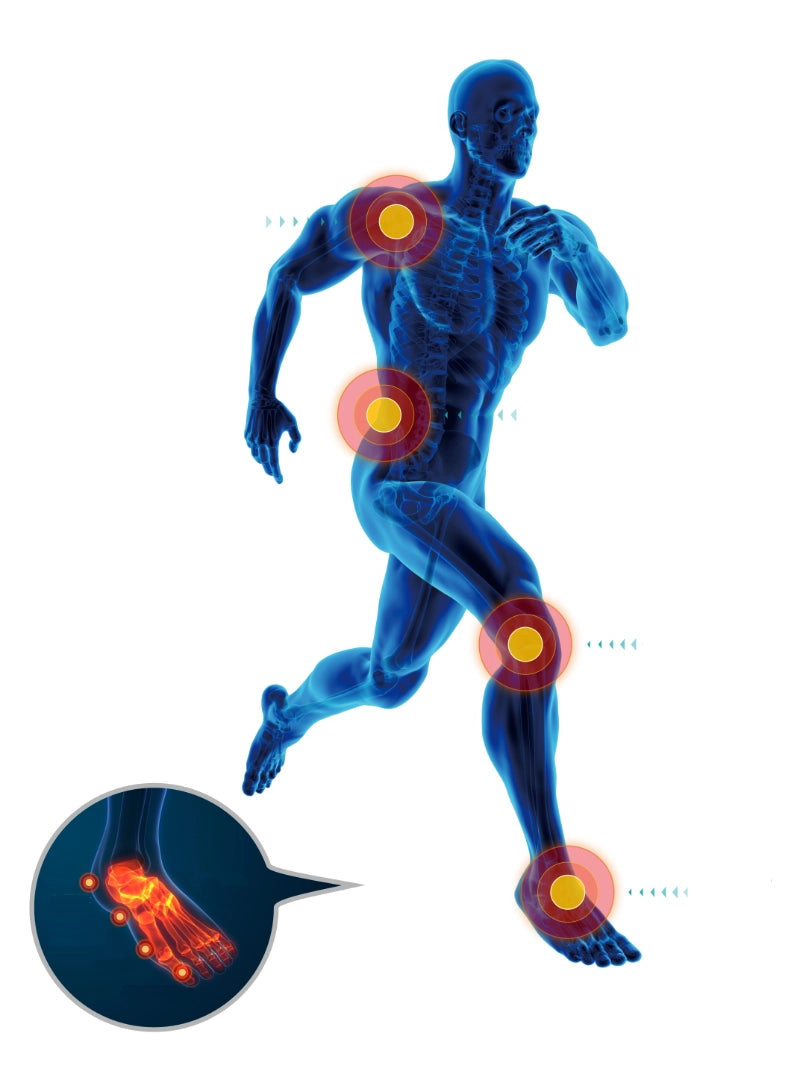
Insoles to enhance performance
We believe that footwear should boost our performance, instead of harm us in the long run. Because every step matters.
For sportsmen and athletes, who train in a reflective and differentiated manner, the idea of performance and prevention is a determining element. It manifests itself in the support of their bodies' biomechanics, where two approaches can be taken:
-

Prevention
Molded comfort-oriented sport insoles for prevention of complaints include a form and force closure between the foot and the shoe. This leads to a significant gain in running comfort with less loss of force during the stance phase.
Comfortable insoles have been described in scientific studies as reducing injuries. These sports insoles are used when athletes have pain in the foot, knee, hip and/or back. The first step is to make sure that the shoe is properly selected. Discomfort is often caused by a bent-kneed condition. The muscles are no longer able to balance in such a way that the joint surfaces are congruent with each other. Here, slow-soled sports insoles can alleviate pain and increase walking and running comfort.
-

Performance
Stimulating sensomotoric performance carbon insoles are designed to mobilize the body's power reserves and enable a more active and dynamic movement. By activating the muscle chains, improved active stabilization of the body segments in the running movement can be achieved.
Therefore, the load on the joints can be minimized which leads to a better performance. Sensomotoric sports insoles can not only remedy the symptoms, but also have a causal influence on the musculature. For example, in the case of a flat foot, the longitudinal arch is not only straightened mechanically from below, but the tibialis posterior muscle is stimulated, which is responsible for straightening the arch.
Which insole for which sport?
Tennis, squash
Rapid changes between stop and go lead to great stress on the joints as well as pressure and shear forces on the feet.
The center of the heel should be cushioned, the half shell should guide the rear foot well. In the forefoot, the sports insole should be made of a material with a memory effect. Insoles made of very soft materials in the forefoot area do not give the athlete enough support.
When selecting shoes, the type of court surface must be taken into account. Dull indoor surfaces require a pivot point integrated into the sole under the metatarsophalangeal joint and little tread. Clay court shoes have a more pronounced tread to provide better footing.
In general, tennis and squash shoes should have a firm sole construction with adequate cushioning and a firm heel counter to stabilize the rear foot. This allows a CC Cordee insole to work optimally. Nevertheless, demands are individual, so we have also provided some tennis players with carbon inserts.
Skiing, ice skating, inline skating
Insoles for these sports are subject to the same principles. Soft insoles ensure a high level of comfort, while firm insoles ensure that small movements from the foot and leg are transferred directly to the piste, ice or road.
A top skier wears firm ski boot shells and firm insoles, just like our CC Carbon is, in a race. Thus, small movements of the athlete are mirrored directly on the slope. The insole is essentially a bedding insole. In a hollowful, the arching is supported. This prevents the high pressure of the buckles from compressing the bulges and the vessels.
Golf
During the stroke movement, there is a high load change from metatarsal one of the swing side to metatarsal five of the tee side. The stroke movement, which is characterized by high movement amplitudes (especially in rotation), requires a high degree of mobility in the pelvis and trunk from the player. This can be supported with proprioceptive or neurological insoles, like our CC Active insoles.
The plantar peunorosis and flexor tendon of the long big toe flexor must be exposed, and the metatarsal head should be softly padded. Important in insole design for golfers is an overall firm insole that provides a high level of comfort while promoting proprioception and ensuring joint stability. Golf shoes feature either soles with replaceable soft spikes or firm traction soles with profiles adapted for different stroke situations. The shoes must provide a good foundation for both the stroke movement and the walking passages.
Football, soccer, baseball
Only well-made sports insoles fit the tight-fitting shoes of these sports. Depending on the ground conditions of the court, these shoes are worn with multi-cam, cam and cleated soles. They must fit precisely, with no length allowances.
With insoles for these shoes, good rearfoot guidance is important to counteract supination trauma. Activation of the peroneal muscles by a sensorimotor element in the lateral rearfoot area can be useful. In addition, a wedge can be used for forefoot pronation. The plantar fascia should be softly bedded. Our CC Carbon insoles are excellently suited. Again, though, individual preference is decisive in the end and some athletes might feel more comfortable with a CC Active insole.
Cycling
The main purpose of insoles in cycling is to provide an effective frictional connection between the foot and the shoe. Due to the lack of rolling motion compared to running, the insole can be significantly stiffer, which, together with the stiffened sole of the cycling shoe, ensures optimal power transmission to the pedal.
CC Carbon insoles are best suited for this purpose. With regard to pressure transmission, the fixation of the shoes to the pedals should be selected in such a way that the physiological pressure load of the forefoot is maintained.



